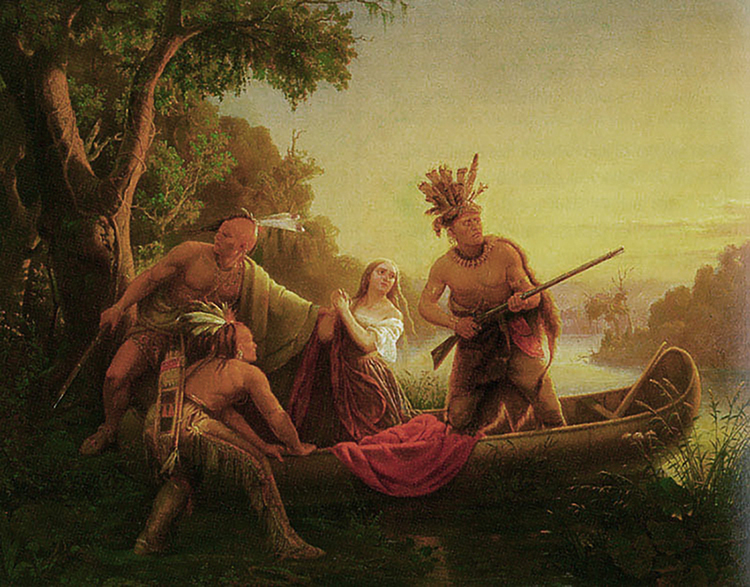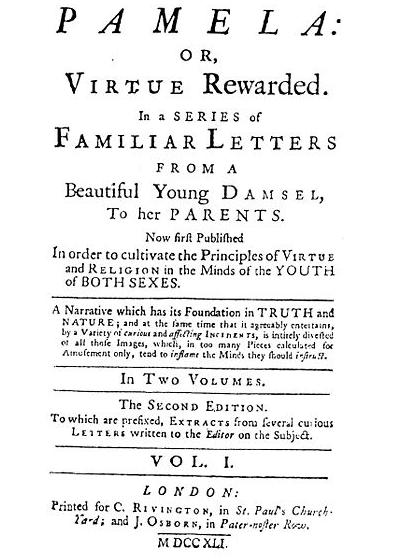|
Captivity Narratives
Captivity narratives are usually stories of people captured by enemies whom they consider uncivilized, or whose beliefs and customs they oppose. The best-known captivity narratives in North America are those concerning Europeans and Americans taken as captives and held by the indigenous peoples of North America. These narratives have had an enduring place in literature, history, ethnography, and the study of Native peoples. They were preceded, among English-speaking peoples, by publication of captivity narratives related to English people taken captive and held by Barbary pirates, or sold for ransom or slavery. Others were taken captive in the Middle East. These accounts established some of the major elements of the form, often putting it within a religious framework, and crediting God or Providence for gaining freedom or salvation. Following the North American experience, additional accounts were written after British people were captured during exploration and settlement in Ind ... [...More Info...] [...Related Items...] OR: [Wikipedia] [Google] [Baidu] |
King William's War
King William's War (also known as the Second Indian War, Father Baudoin's War, Castin's War, or the First Intercolonial War in French) was the North American theater of the Nine Years' War (1688–1697), also known as the War of the Grand Alliance or the War of the League of Augsburg. It was the first of six colonial wars (see the four French and Indian Wars, Father Rale's War and Father Le Loutre's War) fought between New France and New England along with their respective Native allies before France ceded its remaining mainland territories in North America east of the Mississippi River in 1763. For King William's War, neither England nor France thought of weakening their position in Europe to support the war effort in North America. New France and the Wabanaki Confederacy were able to thwart New England expansion into Acadia, whose border New France defined as the Kennebec River in southern Maine. According to the terms of the 1697 Peace of Ryswick that ended the Nine Years' ... [...More Info...] [...Related Items...] OR: [Wikipedia] [Google] [Baidu] |
Hannah Swarton
Hannah Swarton (1651 - 12 October 1708), née Joana Hibbert, was a New England colonial pioneer who was captured by Abenaki Indians and held prisoner for years, first in an Abenaki community and later in the home of a French family in Quebec. She was eventually freed and told her story to Cotton Mather, who used it as a moral lesson in several of his works. Early life Hannah Hibbard (or Hibbert) was the daughter of Robert and Joan Hibbard, baptized on 9 March 1651 at Salem, Massachusetts. She married John Swarton in Beverly, Massachusetts on 8 January, 1670 or 1671. They had five children in Beverly, Massachusetts: * Mary, died on 14 September 1674 * Samuel, baptized 8 November 1674 * Mary, baptized 17 October 1675 * John, baptized 22 July 1677 * Jasper, baptized 14 June 1685 in the First Parish Church in Beverly. In 1687, John Swarton of Beverly received a 50-acre land grant in North Yarmouth. In his petition he said he was from the channel island of Jersey and had ... [...More Info...] [...Related Items...] OR: [Wikipedia] [Google] [Baidu] |
Hannah Duston
Hannah Duston (also spelled Dustin, Dustan, or Durstan) (born Hannah Emerson, December 23, 1657 – March 6, 1736,H. D. Kilgore, "The Story of Hannah Duston" (June 1940), in ''Here's Fifty: The First Hundred Years Are the Hardest,'' Edmund T. Mazur and Garth Clark Dawson. iUniverse, 2008 1737 or 1738) was a woman who was taken captive by |
Cotton Mather
Cotton Mather (; February 12, 1663 – February 13, 1728) was a New England Puritan clergyman and a prolific writer. Educated at Harvard College, in 1685 he joined his father Increase as minister of the Congregationalist Old North Meeting House of Boston, where he continued to preach for the rest of his life. A major intellectual and public figure in English-speaking colonial America, Cotton Mather helped lead the successful revolt of 1689 against Sir Edmund Andros, the governor imposed on New England by King James II. Mather's subsequent involvement in the Salem witch trials of 1692–1693, which he defended in the book ''Wonders of the Invisible World'' (1693), attracted intense controversy in his own day and has negatively affected his historical reputation. As a historian of colonial New England, Mather is noted for his '' Magnalia Christi Americana'' (1702). Personally and intellectually committed to the waning social and religious orders in New England, Cotton Math ... [...More Info...] [...Related Items...] OR: [Wikipedia] [Google] [Baidu] |
Mary Rowlandson
Mary Rowlandson, née White, later Mary Talcott (c. 1637January 5, 1711), was a colonial American woman who was captured by Native Americans in 1676 during King Philip's War and held for 11 weeks before being ransomed. In 1682, six years after her ordeal, ''The Sovereignty and Goodness of God: Being a Narrative of the Captivity and Restoration of Mrs. Mary Rowlandson'' was published. This text is considered a formative American work in the literary genre of captivity narratives. It went through four printings in 1682 and garnered readership both in the New England colonies and in England, leading some to consider it the first American " bestseller". Biography Mary White was born 1637 in Somerset, England. The family left England sometime before 1650, settled at Salem in the Massachusetts Bay Colony, and moved in 1653 to Lancaster, on the Massachusetts frontier. There she married Reverend Joseph Rowlandson, the son of Thomas Rowlandson of Ipswich, Massachusetts, in 1656. Fo ... [...More Info...] [...Related Items...] OR: [Wikipedia] [Google] [Baidu] |
Frontier
A frontier is the political and geographical area near or beyond a boundary. A frontier can also be referred to as a "front". The term came from French in the 15th century, with the meaning "borderland"—the region of a country that fronts on another country (see also marches). Unlike a border—a rigid and clear-cut form of state boundary—in the most general sense a frontier can be fuzzy or diffuse. For example, the frontier between the Eastern United States and the Old West in the 1800s was an area where European American settlements gradually thinned out and gave way to Native American settlements or uninhabited land. The frontier was not always a single continuous area, as California and various large cities were populated before the land that connected those to the East. Frontiers and borders also imply different geopolitical strategies. In Ancient Rome, the Roman Republic experienced a period of active expansion and creating new frontiers. From the reign of Augustus ... [...More Info...] [...Related Items...] OR: [Wikipedia] [Google] [Baidu] |
Native Americans In The United States
Native Americans, also known as American Indians, First Americans, Indigenous Americans, and other terms, are the Indigenous peoples of the mainland United States ( Indigenous peoples of Hawaii, Alaska and territories of the United States are generally known by other terms). There are 574 federally recognized tribes living within the US, about half of which are associated with Indian reservations. As defined by the United States Census, "Native Americans" are Indigenous tribes that are originally from the contiguous United States, along with Alaska Natives. Indigenous peoples of the United States who are not listed as American Indian or Alaska Native include Native Hawaiians, Samoan Americans, and the Chamorro people. The US Census groups these peoples as " Native Hawaiian and other Pacific Islanders". European colonization of the Americas, which began in 1492, resulted in a precipitous decline in Native American population because of new diseases, wars, ethni ... [...More Info...] [...Related Items...] OR: [Wikipedia] [Google] [Baidu] |
Hannah Duston, By Stearns
Hannah or Hanna may refer to: People, biblical figures, and fictional characters * Hannah (name), a female given name of Hebrew origin * Hanna (Arabic name), a family and a male given name of Christian Arab origin * Hanna (Irish surname), a family name of Irish origin Places United States * Hannah, Georgia * Hanna City, Illinois * Hanna, Indiana * Hanna, Louisiana * Hannah, Michigan * Hanna, Missouri * Hannah, North Dakota * Hanna, Oklahoma * Hannah, South Carolina * Hanna, South Dakota * Hanna, Utah * Hanna, West Virginia * Hanna, Wyoming * Hannah Run, a stream in Ohio Elsewhere * Hanna, Alberta, Canada, a town * Hannah, a small village in Hannah cum Hagnaby, a civil parish in Lincolnshire, England * Hana, Iran, a city in Isfahan Province * Hanna, Lublin Voivodeship, Poland, a village * Haná (German spelling: Hanna), an ethnic region in Moravia, Czech Republic * Hannah Island (Greenland) * Hanna Lake, a lake near Quetta, Pakistan Ships * , a destroyer escort acquir ... [...More Info...] [...Related Items...] OR: [Wikipedia] [Google] [Baidu] |
The History Of Maria Kittle
''The'' () is a grammatical article in English, denoting persons or things already mentioned, under discussion, implied or otherwise presumed familiar to listeners, readers, or speakers. It is the definite article in English. ''The'' is the most frequently used word in the English language; studies and analyses of texts have found it to account for seven percent of all printed English-language words. It is derived from gendered articles in Old English which combined in Middle English and now has a single form used with pronouns of any gender. The word can be used with both singular and plural nouns, and with a noun that starts with any letter. This is different from many other languages, which have different forms of the definite article for different genders or numbers. Pronunciation In most dialects, "the" is pronounced as (with the voiced dental fricative followed by a schwa) when followed by a consonant sound, and as (homophone of pronoun ''thee'') when followed by a ... [...More Info...] [...Related Items...] OR: [Wikipedia] [Google] [Baidu] |
Epistolary Novel
An epistolary novel is a novel written as a series of letters. The term is often extended to cover novels that intersperse documents of other kinds with the letters, most commonly diary entries and newspaper clippings, and sometimes considered to include novels composed of documents even if they don't include letters at all. More recently, epistolaries may include electronic documents such as recordings and radio, blog posts, and e-mails. The word ''epistolary'' is derived from Latin from the Greek word ἐπιστολή ''epistolē'', meaning a letter (see epistle). In German, this type of novel is known as a Briefroman. The epistolary form can add greater realism to a story, because it mimics the workings of real life. It is thus able to demonstrate differing points of view without recourse to the device of an omniscient narrator. An important strategic device in the epistolary novel for creating the impression of authenticity of the letters is the fictional editor. Early ... [...More Info...] [...Related Items...] OR: [Wikipedia] [Google] [Baidu] |

_(14566629180).jpg)



.png)
